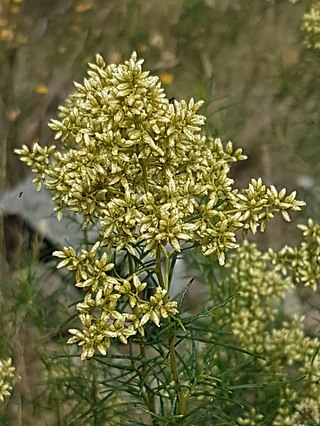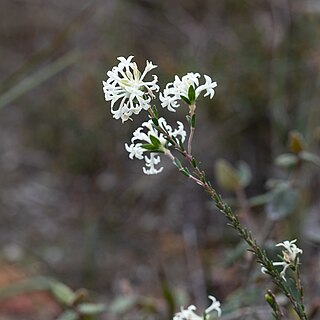
Xerochrysum bracteatum, commonly known as the golden everlasting or strawflower, is a flowering plant in the family Asteraceae native to Australia. Described by Étienne Pierre Ventenat in 1803, it was known as Helichrysum bracteatum for many years before being transferred to a new genus Xerochrysum in 1990. It is an annual up to 1 m (3.3 ft) tall with green or grey leafy foliage. Golden yellow or white flower heads are produced from spring to autumn; their distinctive feature is the papery bracts that resemble petals. The species is widespread, growing in a variety of habitats across the country, from rainforest margins to deserts and subalpine areas. The golden everlasting serves as food for various larvae of lepidopterans, and adult butterflies, hoverflies, native bees, small beetles, and grasshoppers visit the flower heads.

Ozothamnus ferrugineus, commonly known as tree everlasting, is a member of the genus Ozothamnus, of the Asteraceae family – one of the largest families of flowering plants in Australia. Native to the Australian states of New South Wales, Victoria, South Australia, and Tasmania, it forms an erect shrub or small tree between 2 and 3 metres in height.

Podolobium alpestre, commonly known as alpine shaggy-pea, is a flowering plant in the family Fabaceae and is endemic to south-eastern Australia. It has oblong to egg-shaped leaves and yellow to orange pea-like flowers with red markings.

Ozothamnus secundiflorus, the cascade everlasting, is an aromatic shrub species, endemic to Australia. It grows to between 0.5 and 2 metres in height. Leaves are 6 to 10 mm long and 1.5 to 4 mm wide. These are dark green with grey hairs on the upper surface, and white tomentose below. The white flower heads appear in dense clusters along one side of the stem between December and February in the species' native range.

Asterolasia trymalioides, commonly known as alpine star-bush, is a species of erect, sometimes prostrate shrub that is endemic to eastern Australia. It has leathery, narrow elliptical to circular leaves densely covered with star-shaped hairs on the lower surface, and yellow flowers arranged singly in small groups on the ends of branchlets, the back of the petals covered with brown, star-shaped hairs.

Coronidium elatum, commonly known as the white paper daisy or tall everlasting, is a perennial herbaceous shrub in the family Asteraceae found in open forests in eastern Australia. A woody shrub 0.6 to 2 m tall, it has white flowers which appear in spring. It was known as Helichrysum elatum for many years until it was finally reviewed in 2008.

Ozothamnus alpinus, commonly known as alpine everlasting, is a flowering plant in the family Asteraceae. It is endemic to alpine and subalpine areas in south-eastern continental Australia.

Ozothamnus cuneifolius, commonly known as wedge-leaf everlasting or wedge everlasting, is a shrub in the family Asteraceae. It is native to forests of the south-east of New South Wales and Gippsland in Victoria in Australia.

Ozothamnus rogersianus, commonly known as Nunniong everlasting, is a shrub in the family Asteraceae. It is endemic to Victoria, Australia.

Ozothamnus thyrsoideus, commonly known as sticky everlasting, is a flowering shrub, endemic to south-eastern Australia. It grows to between 0.5 and 2 metres in height. Leaves are 15 to 30 mm long and 1.5 to 2 mm wide. Flowerheads appear in terminal corymbs in the summer.

Cassinia quinquefaria is a species of flowering plant in the family Asteraceae and is endemic to eastern Australia. It is a shrub with sticky, hairy foliage, linear leaves, and heads of creamy-white flowers arranged in a dense panicle.

Cassinia longifolia, commonly known as shiny cassinia, is a species of flowering plant in the family Asteraceae and is endemic to eastern Australia. It is an erect, aromatic shrub with sticky, hairy foliage, linear or oblong to narrow lance-shaped leaves, and heads of creamy-white flowers arranged in a dense corymb.

Pityrodia ternifolia is a species of flowering plant in the mint family, Lamiaceae and is endemic to north-western Australia. It is an erect shrub with densely hairy stems, sticky and prickly, egg-shaped leaves, and mauve or pinkish-red, tube-shaped flowers.

Helichrysum calvertianum is a species of flowering plant in the family Asteraceae. It is a small subshrub with small crowded leaves and single white daisy-like flowers. It is endemic to the Southern Highlands in New South Wales.
Cassinia complanata, commonly known as smooth cassinia, is a species of flowering plant in the family Asteraceae and is endemic to south-eastern Australia. It is a shrub with sticky, densely hairy stems, narrow linear to cylindrical leaves and heads of small flowers arranged in corymbs.
Ozothamnus tesselatus, commonly known as tesselate everlasting, is a flowering plant in the family Asteraceae. It is a small shrub with woolly branches and globular heads of whitish to straw-coloured flowers.

Pimelea phylicoides, commonly known as heath rice-flower, is a species of flowering plant in the family Thymelaeaceae and is endemic to southern continental Australia. It is an erect shrub with densely hairy young stems, narrowly egg-shaped to elliptic leaves, and heads of white flowers surrounded by 3 to 6 involucral bracts.

Calocephalus lacteus, commonly known as lemon beauty-heads, is a species of flowering plant in the family Asteraceae. It has yellow cylindrical shaped flowers and grey stems and grows in the eastern states of Australia

Brachyscome spathulata, commonly known as spoon-leaved daisy, is a flowering plant in the family Asteraceae. It has dark green leaves, mauve daisy-like flowers and grows in New South Wales, Tasmania, Victoria and the Australian Capital Territory.

Ranunculus pimpinellifolius, commonly known as bog buttercup, is a flowering plant in the family Ranunculaceae and grows in eastern Australia. It is a low growing perennial with divided green leaves and yellow flowers.


















